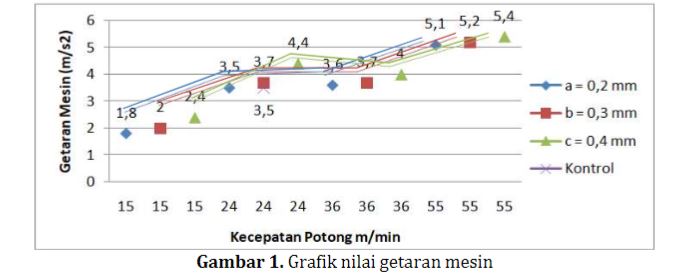Analisis Variasi Kecepatan Potong Dan Kedalaman Potong Terhadap Nilai Kekasaran Permukaan Dan Getaran Pada Pembubutan Silindris Material Baja ST 60
Abstract
Conventional lathes are still often used, but the problem is that conventional lathes are difficult to get really good product quality (geometric dimensions, surface roughness and appropriate reflective geometries) due to human factors, the cutting parameters used and the condition of the machine itself. The purpose of this study was to determine how much the effect of cutting speed and depth of cut on vibration and surface roughness in the cylindrical turning process. This research is a quantitative research using experimental methods. For data collection using the technique of observation and documentation methods. Date analysis techniques using regression analysis techniques. The research results that have been obtained, it is known that the highest engine vibration value is 5.4 m/s2 and the lowest is 1.8 m/s2. The highest vibration value of the chisel is 5 m s2 and the lowest is 1 m/s2. And for the highest surface roughness is 5.0 µm and the lowest is 2.33 µm. And it can be concluded that the higher the cutting speed and the depth of cut, the machine vibration, chisel vibration and roughness will be higher.
References
Bahanuddin, Y., Harun, S., Afriant, E., dan Tony, D., A. 2013. Penerapan Penilaian Kekasaran Permukaan (Surface Roughness Assessment) Berbasis Visi pada Proses Pembubut an Baja S45C. Jurnal Mechanical 4(1): 22-29
Hardijito, A. 2018. Analisis Radius Pemutus Beram Terhadap Kekasaran Permukaan pada Proses Bubut. Info Teknik. 19 (2): 167-180.
Hasrin. 2013. Pengaruh Tebal Pemakanan dan Kecepatan Potong Pada Pembubutan Kering Menggunakan Pahat Karbida Terhadap Kekasaran Permukaan Material ST 60. Jurnal Teknologi 13(2): 1-8.
Husein S. dan Djumhariyanto D. 2015. Analisis Sudut Potong Terhadap Getaran Pahat dan Kekasaran Permukaan pada Proses Bubut Mild Steel. Jurnal Ilmiah Teknik 5(1): 1-11.
Ipilakyaa, T. D., Gundu, D. T., dan Gbashi, S. 2018. Effect of Cut Thickness and Cutting Speed on Vibration Tool in Cylindris Cutting of Mild Carbon Steel. European Jourrnal of Materials Science and Engineering 3(3): 133-139.
Karyasa, T. B. 2011. Dasar Dasar Getaran Mekanis. Cet 1. Yogyakarta: CV. Andi Offset.
Paridawati. 2015. Pengaruh Kecepatan dan Sudut Potong Terhadap Kekasaran Benda Kerja pada Mesin Bubut. Jurna Ilmiah Teknik Mesin 3(1): 53-67.
Sihasale, J. D . 2016. Analisa Getaran Rotor Simulator dengan Menggunakan FFT (Fast Fourier Transform). Jurnal Teknik Mesin 14(2): 1-8.
Singh, J. K., dan Bhardwaj, S.K. 2015. Optimization of the Cutting Parameters by Vibration Analysis of Cutting Tool.
Internasional Journal of Latest Trends in Engineering and Technology (IJLTET),1(5): 270-275.
Siswanto, B., dan Sunyoto. 2018. Pengaruh Kecepatan dan Kedalaman Potong pada Proses Pembubutan Konvensional Terhadap Kekasaran Permukaan Lubang. Jurnal Dinamika Vokasional Teknik Mesin, 3(2): 82-86.
Suarsana, I. K. 2017. Ilmu Material Teknik. Denpasar: Nilacakra.
Sugiyono. 2015. Metode Penelitian: Pendekatan Kuantitatif, kualitif, dan R&D. Bandung: Alfabeta.
Sutrisna, K., Nugraha, N. P., dan Dantes, K. R. 2017. Pengaruh Variasi Kedalaman Potong dan Kecepatan Putar Mesin Bubut Terhadap Kekasaran Permukaaan Benda Kerja Hasil Pembubutan Rata Pada Bahan Baja ST 37. Jurnal Teknik Mesin 5(3): 1-8.
Syamsudin, A. R., dan Damianti. 2011. Metode Penelitian Pendidikan Bahasa. Bandung: Remaja Rosdakarya.
Widarto, Wijananka, B. S., dan Paryanto. 2008. Teknik Pemesinan untuk Mengah Kejuruan. Jakarta: Direktorat Jendral Manajemen Pendidikan Dasar dan Menengah.


